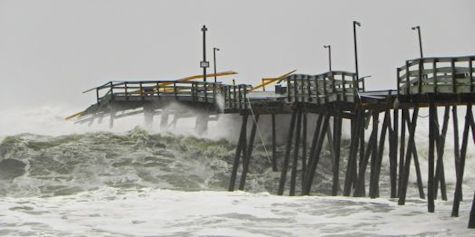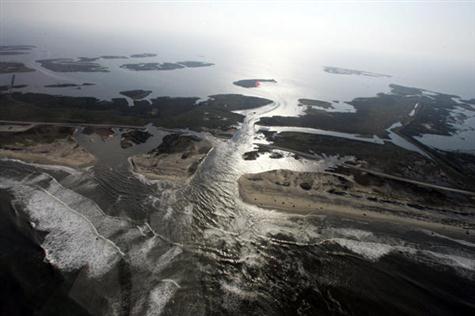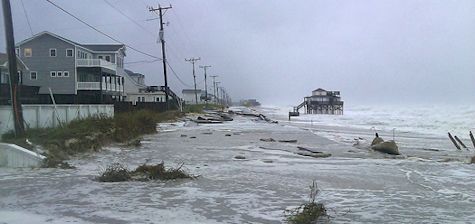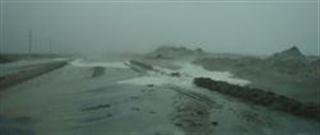Part 2 in Climate, Insurance and the Coast
In June, the state legislature passed a bill placing a four-year ban on acknowledging rising sea levels due to climate change. The bill was created after the Science Panel on Coastal Hazards of the state Coastal Resources Commission projected that sea levels could rise 39 inches by 2100.
Supporter Spotlight
The projection was based, in part, on a U.S. Geological Survey study that states that since 1980, a 600-mile stretch of the Atlantic coastline between Cape Hatteras and Boston has experienced a rise in sea level that is three to four times the global average.
 Avalon during Hurricane Sandy. Photo by Kermit Skinner |
Backers of House Bill 819 say projections using historical data from tide gauges and carbon dioxide levels predict a rise of no more than eight inches and argue that sea levels are receding in some coastal areas.
Tom Thompson, chairman of NC-20, a coalition of land development businesses and approximately eleven counties, said there is no solid basis for the 39-inch projection.
 This Aug. 2011 photo shows a flooded road on Hatteras Island, N.C., after Hurricane Irene swept through the area. Photo by Jim Bounds, AP |
“That’s an enormously rapid increase,” he said. “Part of our problem with that projection is that there is no acceleration of that kind anywhere in the world. What people forget is that these things have been going on for centuries. The hype about the insurance industry’s vulnerability on the coast is just exactly that.”
In any given year the industry could lose money, Thompson said, but spread the risks in terms of time and geography and the losses aren’t as stark as the industry suggests.
Supporter Spotlight
 Kitty Hawk in Hurricane Sandy. Photo by Kermit Skinner |
He points to the North Carolina Insurance Underwriting Association’s Beach Plan, which in September 2011 had retained earnings of more than $630 million, according to information provided by the NCIUA.
The Beach Plan incurred losses from 1980 to 2011 of more than $781 million and the plan’s net earned premium was more than $1.5 billion. During that same period Beach Plan member companies paid in more than $906 million in contributions and received net distributions of more than $146 million from the plan, paying in more than $760 million than they have received, according to NCIUA.
But one major storm, like Hurricane Sandy, which left in its wake a staggering estimated $30 billion to $50 billion in property and economic losses, has the potential to dry up such reserves.
 N.C. 12 overwash during Sandy. Photo by Kermit Skinner |
“You have to have many good years in order to accumulate enough funds to pay for the bad years,” Marlett said. “The severity of some of these hurricanes is so large that they can wipe out decades of profits.”
After Hurricane Andrew hit south Florida in 1992, Allstate lost more than the company had ever collected up to that point in that state, he said.
“What we can expect to see is insurance companies providing less coverage along the coast,” Marlett said.
That means, predictably, government agencies will be expected to fill the void. The question is where the money will come from to fund those costs, Marlett said.
According to the Ceres report, “total government exposure to losses in hurricane-exposed states has risen more than 15-fold to $885 billion” since 1990.
Commercial insurance buyers are paying more for certain types of coverage, according to the report. Consumers are paying higher insurance premiums.
Long-term solutions, Marlett said, include mitigation – making buildings stronger, implementing better land use management practices along the coast and enforcing stronger building codes.
Communities on the east and west coasts are already discussing ways to plan for greater resiliency in future storms, McHale said.
New York City leaders have taken “great strides” to understand the implications of rising sea level projections and to look at which investments are cost-effective in building their own resiliency, she said. Boston has been a leader in the greenhouse gas mitigation front, looking at renewable energy alternatives.
On the west coast, San Diego has led a study on how to adapt to sea level rise. The Sea Level Rise Adaptation Strategy for San Diego Bay was released in February. A collaboration of local governments around San Diego Bay, the Port of San Diego, San Diego Airport Authority and others, the report evaluates how community assets could be impacted by sea level rise and recommends building resilience of community assets.
Since insurers are influential in risk-reduction practices, it is critical that insurers are involved these discussions, McHale said.
“I think that being smart and being able to look forward and understanding some of the changes that are facing us is critical for any town or city in terms of planning for its own economic well-being,” McHale said. “Honestly, the hard work is still ahead of us. There’s an awful lot to be done and I don’t pretend to trivialize it. We’re going to pay one way or another.”







